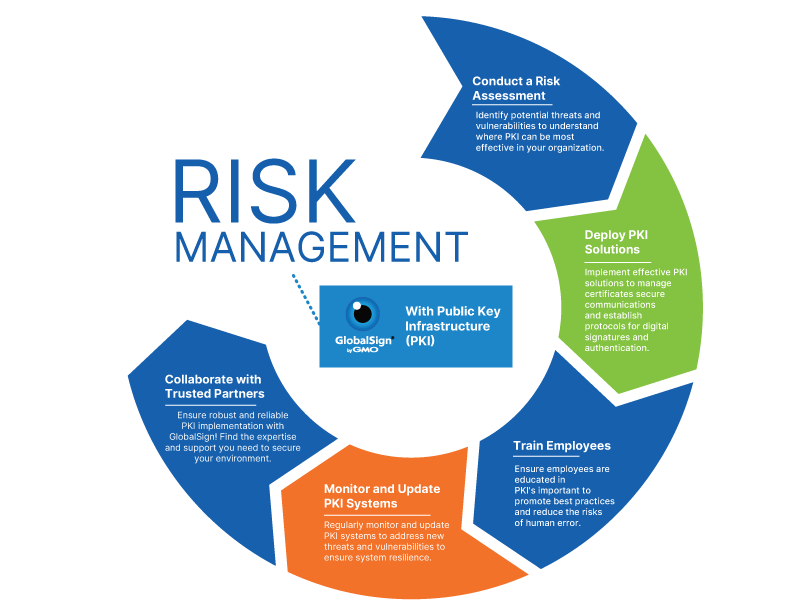In today’s digital world, risk mitigation and management is essential for any business. With cyber threats constantly evolving, it’s crucial to have strong measures in place to protect your data, assets, and reputation. Public Key Infrastructure (PKI) is a key tool for this job, helping secure communications, verify identities, and maintain data integrity. This blog will explain why PKI is so important for managing those risks and how companies can use it effectively.
What Is Risk Management?
Risk management is about identifying potential problems that could harm your business and taking steps to prevent or minimize them. This includes protecting against data breaches, unauthorized access, and cyberattacks. Good risk management keeps your business running smoothly, protects sensitive information, and maintains customer trust.
The Role of PKI in Risk Management
1. Ensuring Data Integrity and Confidentiality
PKI uses cryptographic keys and digital certificates to secure communications and data exchanges. By encrypting data, PKI ensures that only authorized parties can access and read sensitive information. This is crucial for maintaining the confidentiality and integrity of data, which are fundamental aspects of risk management.
Cyber incidents, such as cybercrime and data breaches, were reported as the leading risk to businesses globally for 2023 by 34% of risk management experts. (Statista)
2. Enhancing Authentication and Access Control
One of the primary functions of PKI is to provide strong authentication mechanisms. Digital certificates serve as electronic credentials, verifying the identities of users, devices, and servers. This reduces the risk of unauthorized access and ensures that only legitimate users can access critical systems and data.
The average cost of a data breach reached an all-time high in 2023 of USD 4.45 million. This represents a 2.3% increase from 2022. (IBM's Cost of a Data Breach Report 2023)
3. Enabling Secure Transactions
For businesses that conduct online transactions, PKI is essential for securing these exchanges. Digital signatures, enabled by PKI, provide proof of the origin, identity, and status of an electronic document, transaction, or message. This non-repudiation ensures that transactions are legitimate and traceable, reducing the risk of fraud.
Phishing and stolen or compromised credentials were responsible for 16% and 15% of data breaches, respectively, in 2023. (IBM's Cost of a Data Breach Report 2023)
4. Supporting Compliance and Regulatory Requirements
Many industries are subject to stringent regulatory requirements regarding data protection and privacy. PKI helps businesses comply with standards such as GDPR, HIPAA, and PCI-DSS by providing secure methods for data encryption, authentication, and digital signing. Compliance with these regulations is a critical component of risk management, helping to avoid legal penalties and reputational damage.
83% of risk and compliance professionals said that keeping their organization compliant with all relevant laws, policies, and regulations was a very important or absolutely essential consideration in its decision-making processes. (Navex Global's 2023 Definitive Risk & Compliance Benchmark Report)

Integrating PKI into Your Risk Management Strategy
1. Conduct a Risk Assessment
Begin by conducting a thorough risk assessment to identify the potential threats and vulnerabilities within your organization. This assessment will help you understand where PKI can be most effective in mitigating risks.
2. Deploy PKI Solutions
Implement PKI solutions tailored to your organization's needs. This includes issuing and managing digital certificates, setting up secure communication channels, and establishing protocols for digital signatures and authentication.
Here are some solutions to consider:
- Certificate Automation Manager: A completely customizable solution which uses preset policies to automatically provision certificates
- Managed PKI: Provides centralized control over certificate and user activity
- ACME: A SaaS based lightweight solution that automates TLS Certificate Management
- PKI for DevSecOps: Implement Security in your DevSecOps Pipeline with compliant SSL / TLS Certificates
- Document Signing Solutions: Documents Signed with Confidence, Integrity, and Trust. Electronic, digital, AATL, eIDAS & PSD2
- Secure Email: S/MIME certificates means employees can easily identify whether an email is legitimate. Seamless deployment process for IT admins and end users
- IoT: Provision, secure and manage device identities with a PKI-based cloud IoT Identity Platform that's scalable and flexible
3. Train Employees
Ensure that your employees are trained in the importance of PKI and how to use it effectively. Human error is a significant risk factor, and proper training can mitigate this risk by promoting best practices in security.
4. Monitor and Update PKI Systems
Regularly monitor and update your PKI systems to address emerging threats and vulnerabilities. This includes renewing certificates, updating cryptographic algorithms, and ensuring that your PKI infrastructure is scalable and resilient.
5. Collaborate with Trusted Partners
Work with GlobalSign, your trusted partner, to ensure that your PKI implementation is robust and reliable. We can offer expertise and support to help you maintain a secure and compliant PKI environment.

Final Thoughts
Incorporating PKI into your risk management strategy is no longer optional—it's a necessity. With the increasing sophistication of cyber threats, businesses must adopt comprehensive security measures to protect their assets and maintain trust. PKI provides the foundation for secure communications, strong authentication, and data integrity, making it an indispensable tool in the fight against cyber risks. By leveraging PKI, companies can enhance their risk management practices, ensure compliance, and safeguard their digital future.
Take Action
Ready to enhance your risk management strategy with PKI? Contact us today to learn how our comprehensive PKI solutions can safeguard your business against evolving cyber threats. Let’s build a secure and resilient future together.
Introduce effective risk management into your infrastructure with GlobalSign








